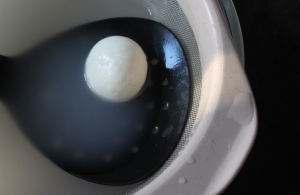This month, I have got quite a few cheese posts on the way, inspired by the Cheese, Please! Challenge over at Fromage Homage. As soon as she announced that the challenge this month was to be fresh cheese, I knew I wanted to play. My mind was racing over the possibilities (of which, more to come), but I have a birthday party coming up and I want to let the kids make pizzas (with ingredients made from scratch, of course!). The obvious place to start on my fresh cheese odyssey is with mozzarella. I’m probably going to enter all of my recipes in one larger round-up post at the end of the month, but I am going to share the individual recipes that I make with all the fresh cheeses too.
So, we’ll start at the very beginning; a very good place to start; mozzarella, a fresh cheese with bounce!
I looked around online, and decided that mozzarella from scratch can’t be that hard, can it? I quickly found a few nice recipes, which I cobbled together to come up with my techniques I share here. Most of the recipes include using a microwave, which I don’t have. Instead I have been most inspired by the Barefoot Kitchen Witch and the techniques used in this post from the New England Cheese Supply Company.
Making one’s own mozzarella counts as a fresh cheese recipe, doesn’t it? So I think it will be a great entry for Cheese, Please! And even if it is really only precursor for the actual recipes, it doesn’t matter, it was pretty simple, I had a lot of fun, and I have the softest hands I have had in ages, so that’s an added bonus!
Recipe: Home Made Mozzarella
Ingredients
2 l milk – you can use whole, semi skimmed, pastuerised or whatever you like really. The only milk that doesn’t work is UHT.
¾ tsp citric acid, dissolved in 60 ml blood temp water
2 drops vegetarian rennet in 30 ml cold water
Salt to taste
If you do not have a measuring jug that allows you to measure such small amounts of liquid, remember that 1 ml of water =1 g, so you might find it a lot easier to simply weigh the water.
In the Netherlands, rennet is called stremsel, which I personally think sounds a lot nicer. The great news, whatever you call it, is that vegetarian and original rennet are widely available. My regular online brewshop stocks all varieties, as well as citric acid, which is great for me!
In addition to the ingredients, it is a good idea to gather together the equipment you will need before you start.
Equipment
Large saucepan
Thermometer, preferably one that can measure low temps
Cheesecloth or muslin, sterilised by boiling
Sieve
Slotted spoon
At least four large bowls
Boiling water
Ice
Method
Add the milk to your saucepan, with the dissolved citric acid. Heat gently until it gets to 32ºC. If, like me, your thermometer will not measure that low (I used my jam thermometer, which starts at 60ºC), heat very gently until your curds look like the photo above. When you stick a (clean) finger in it, it will feel cooler than you, but not that much.
Add the rennet water, and heat a little bit more to 37-38 degrees. Again, if your thermometer doesn’t go that low, then use the photo above. You will not feel a temperature difference if you stick your finger in this liquid.
Take the curds from the heat, then allow to sit for 5 minutes or so. You will clearly see the separation of the curds and the whey, which will look more watery. Cut the curds crossways with a sharp knife.
Line your sieve with a cheesecloth, or muslin square, and place over one of the bowls. With a slotted spoon, remove the curds from the pan, and put them in the sieve. They will look quite wet, like above. Cut and fold them over with the slotted spoon, to get rid of some more of the whey.
The curds will go from watery to looking much drier, and will lose quite a lot of volume. Don’t throw away the whey, it has a lot of uses, and keeps for a long time in the fridge.
Remove the curds to a separate bowl, and knead for a little bit, until it looks a lot less lumpy. Boil enough water to allow you to sit your sieve on a third bowl, so that the sievey bit is submerged. Get a different bowl of iced water ready as well.
Place the curds in the sieve in the hot water, and allow them to pour, stretch and fold off the slotted spoon. I’m sorry, I didn’t get a good picture of this, because it’s pretty hard to do this and photograph yourself, and the Big Guy was at work. Anyway, it will start to get more stretchy and smoother as you go on.
As the water cools, the cheese will stop stretching. Once this happens, boil a kettle again. While it is boiling, remove the curds to the bowl and knead some more. At this stage, add some salt to taste, and knead to mix well.
Repeat submerging in the boiled water, stretching and then kneading until you have a stretchy, pliable cheese. You can either shape this as one large ball, or divide it into smaller balls if you prefer.
I found it easier to use the hot water for one final shaping. I used the sieve and the slotted spoon to roll the cheese around in the hot water to make a ball shape.
Once you have shaped the cheese, submerge in iced water. Mozzarella should be used fresh, but can be stored in briney water the fridge for up to 4 days.













Wow, that looks brilliant! Way (whey!) better than when I tried it and they looked like rubber band balls. Yum!
Wow, thanks! I think I could probably have worked them a bot more, but they will be great on pizza. I’ve a load more recipes for this month. Is it easier to do you a round up and link to that later?
Whatever works best for you 🙂
ooh interesting! what sort of quantity do you get from your 2 litres of milk? And why doesn’t it matter what sort of milk you use? I would love to give this a go 🙂
Hello Joanna! I got about 150 g of cheese. I think I could have got quite a bit more, had I known what I am doing, but I’m happy for a first go. I thought I was going to get ricotta, but it turns out the acid whey isn’t good for that sort of cheese. I can (and will be) making things with the whey, however. 🙂
I think as long as the milk hasn’t been superheated, as happens in the process to make milk long life, then it will still have useful milk proteins (including casein, but there are other important ones) in it.The UHT process denatures these proteins. However, the curd content is also dependent on fat, so there will be less from skimmed cows milk, and the most from whole sheep’s milk, I think. I read today that it is even possible to make cheese from powdered milk, but I have’t tried it yet.
Love, love, love this! Looking forward to the cheese postings to come (I adore cheese!)
Thanks Diva! You should definitely check out the link on Fromage Homage. I know she also has some really great recipes up there too.
Wow – I am impressed. It has never even crossed my mind to make mozzarella from scatch!
Thanks! I love to know how things work, in case I ever really do go and live off grid 😉 It was a lot of fun to try though. I’m going to have to come up with more stuff soon, I had to buy 50 ml of liquid rennet, which I think has a fairly short shelf life.
I am so impressed! Can’t believe you made your own mozzarella, and it looks so yummy too! 🙂
Thanks Petra, It was really fun, and so pleasing when it all came together 🙂
Hats off! That looks terrific.
Wow, thanks very much 🙂
Wow, this looks amazing! Really interesting post. Look forward to reading more x
Thankyou for the comment and for visiting. As I mentioned, my next few posts will be decidedly cheesey 😉
Yum!! X
Wow! You made your own cheese! Cool. Which reminds me of making tofu😄. Quite similar process. Love the final result. Silky smooth mozzarella ball. Just like the real McCoy. Thanks for sharing with us, however I still need to find out what rennet or Stremsel is😃
Yes, I’ve always fancied having a go at making my own tofu, too. Someday I’ll get around to it.
Rennet/ Stremsel is an enzyme complex that will coagulate milk, to make the whey and the curds required for cheese making. Traditionally, it is extracted from cows’ stomachs, but these days you can get vegetarian versions.
Is the watery liquid in which cuts of sour milk float, the whey? I left half a bottle of milk out by error on one of the very warm days and came home to curd floating in liquid.. could this liquid be used to ferment drinks?